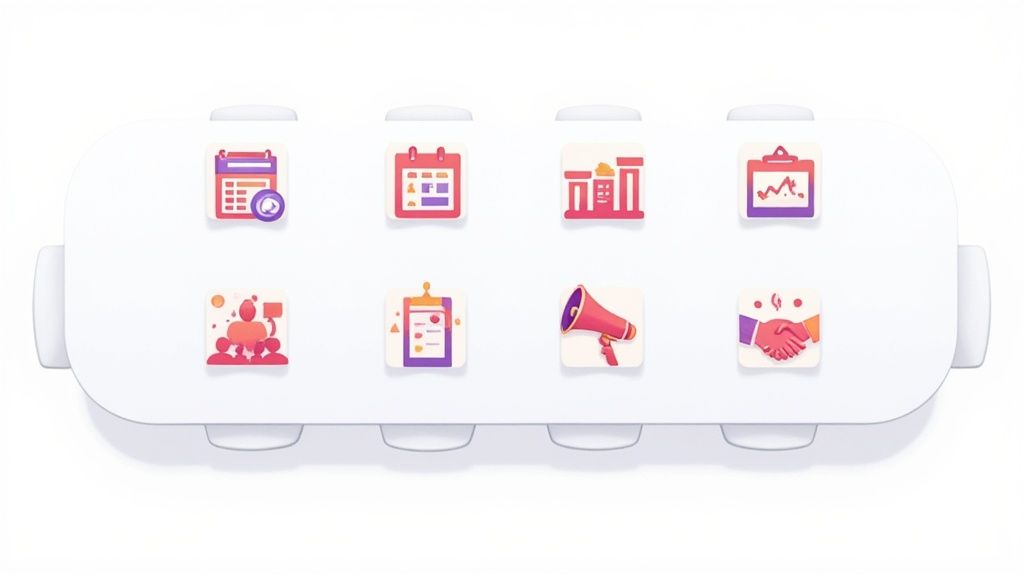Planning a corporate event in today's dynamic environment is more complex than ever. It's no longer just about booking a venue and sending invitations; it's about crafting an immersive experience that achieves tangible business outcomes. Whether you're organizing a large-scale international conference, an intimate client appreciation dinner, or a company-wide virtual summit, the core principles of strategic planning remain the same.
Success hinges on a delicate balance of meticulous detail, creative vision, and flawless execution. A single misstep in logistics or strategy can impact everything from attendee satisfaction and engagement to the event's ultimate return on investment. This is why having a structured approach is critical. For a holistic view of event preparation, you can refer to a resource offering a comprehensive event planning checklist to ensure no detail is overlooked from the start.
This guide is designed to navigate the complexities of modern event management, providing you with a comprehensive collection of actionable corporate event planning tips. We will move beyond the obvious, offering deep insights and practical frameworks to help you elevate your events from standard gatherings to strategic assets. Prepare to master the art and science of corporate event planning, ensuring every initiative you touch is a resounding success that drives growth, engagement, and brand loyalty. We will cover everything from defining clear objectives and building a comprehensive budget to integrating technology, curating high-quality content, and measuring your final ROI.
1. Define Clear Objectives and Goals
Before a single venue is scouted or a speaker is booked, the most critical step in corporate event planning is to define what success looks like. This foundational stage involves establishing specific, measurable objectives that align directly with your organization's broader business goals. Without clear objectives, your event lacks direction, making it impossible to measure return on investment (ROI) or justify its budget.

Defining your event's purpose guides every subsequent decision, from content programming and technology choices to marketing messages and attendee experience. Are you aiming to generate qualified leads, boost employee morale, launch a new product, or educate existing customers? Each goal demands a unique strategic approach.
How to Set Effective Event Objectives
The most effective way to structure your goals is by using the SMART framework. This widely adopted methodology ensures your objectives are well-defined and actionable.
- Specific: Instead of "increase brand awareness," aim for "increase brand mentions on LinkedIn by 30% during the week of the event."
- Measurable: Define the key performance indicators (KPIs) you will track. This could be the number of sales-qualified leads generated, a target score on post-event satisfaction surveys, or the total number of demo requests.
- Achievable: Set ambitious but realistic targets based on past performance, available resources, and market conditions.
- Relevant: Ensure the event’s goals directly support wider company initiatives, such as quarterly sales targets or annual growth plans.
- Time-bound: Assign clear deadlines for achieving your objectives, such as "Generate 200 new MQLs by the end of Q3 through post-event follow-up."
Practical Application and Examples
Involve key stakeholders from sales, marketing, and leadership in the goal-setting process to ensure alignment across departments. A collaborative session can help identify both primary and secondary objectives. For example, a primary goal might be lead generation, while a secondary goal could be strengthening partner relationships.
Consider how major tech companies structure their flagship events:
- Salesforce's Dreamforce: Primarily focused on customer education, lead generation, and building its ecosystem of partners.
- Microsoft's Build: Tailored specifically for developer engagement, encouraging adoption of its platforms and tools.
- Google I/O: Centers on major product announcements and fostering its global developer community.
By establishing this strategic foundation, you create a clear roadmap that empowers your team, justifies your budget, and provides a concrete framework for measuring success. This is one of the most vital corporate event planning tips for delivering impactful and valuable experiences.
2. Create a Comprehensive Budget and Timeline
Once your objectives are set, the next critical step is to build the operational backbone of your event: a comprehensive budget and a detailed timeline. These two elements are intrinsically linked and serve as your roadmap for execution. Without meticulous financial and chronological planning, even the best-laid plans can quickly derail, leading to cost overruns, missed deadlines, and a compromised attendee experience.

A well-structured budget accounts for every potential expense, from major line items like venue rental and catering to often-overlooked costs such as payment processing fees and staff travel. Similarly, a realistic timeline ensures every task, from vendor negotiation to post-event analysis, is allocated sufficient time. This dual framework is one of the most essential corporate event planning tips for maintaining control and ensuring a smooth process.
How to Build an Effective Budget and Timeline
Your budget should be a line-item-specific document, while your timeline should be a reverse-engineered plan working backward from the event date. Start by listing every conceivable cost category and then research to get accurate estimates. For the timeline, map out major milestones first and then fill in the smaller, dependent tasks.
- Categorize Expenses: Break down your budget into logical categories like Venue, Technology (A/V, Wi-Fi), Food & Beverage, Marketing & Promotion, Speakers & Entertainment, and Staffing.
- Track Everything: Use a spreadsheet or event management software to track projected costs versus actual spending in real-time. This provides a clear financial picture at every stage.
- Build in Contingency: A non-negotiable rule is to allocate 10-15% of your total budget to a contingency fund. This buffer covers unexpected expenses and last-minute changes without derailing your entire financial plan.
- Use Project Management Tools: Platforms like Asana, Monday.com, or Trello are invaluable for timeline management. They allow you to assign tasks, set deadlines, and monitor progress collaboratively. You can explore a detailed event planning timeline template to see how these are structured.
Practical Application and Examples
For major corporate events, planning should ideally begin 6 to 12 months in advance. This allows ample time for venue selection, contract negotiations, and securing in-demand speakers.
Consider the meticulous planning behind major industry events:
- Apple's Product Launches: Famously planned with timelines stretching up to 18 months, ensuring every detail of the keynote and attendee experience is perfectly polished.
- IBM's Think Conference: Utilizes a phased budget approval process, where funds are released as key milestones are met, ensuring financial accountability throughout the long planning cycle.
- Oracle CloudWorld: Relies on extremely detailed budget breakdowns that are reviewed weekly, allowing for agile adjustments based on registration numbers and sponsorship sales.
By establishing a robust budget and a realistic timeline from the outset, you create a powerful control system that minimizes risk, empowers your team to stay on track, and ultimately drives the successful execution of your event.
3. Choose the Right Venue and Format
The selection of a venue and event format is a cornerstone decision that directly shapes the attendee experience, logistical feasibility, and overall atmosphere of your event. This choice extends beyond just four walls; it encompasses accessibility, technology, ambiance, and budget, making it a critical step in executing a successful corporate event. The right environment can amplify your message, while the wrong one can create friction and detract from your goals.

Whether you opt for an in-person gathering, a fully virtual conference, or a hybrid model, this decision must align with the objectives you established earlier. The format dictates the technology you'll need, while the venue sets the physical and emotional tone. A misstep here can lead to logistical nightmares, poor attendance, and a disconnected audience.
How to Select the Ideal Venue and Format
Your choice should be a strategic balance between your event's purpose, your audience's needs, and your budget. Start by determining the most suitable format: in-person for deep networking, virtual for maximum reach and accessibility, or hybrid to capture the benefits of both.
- Analyze Your Audience: Where are they located? Are they tech-savvy? What are their travel and budget constraints? An international audience may be better served by a virtual or hybrid format.
- Align with Event Goals: A high-touch networking event for C-suite executives requires an intimate, high-end physical venue. A global product launch aiming for mass awareness is a perfect candidate for a large-scale hybrid or virtual format.
- Evaluate Technical Requirements: For in-person and hybrid events, assess the venue's Wi-Fi capabilities, AV equipment, and power supply. For virtual events, vet the platform's stability, engagement features, and streaming quality.
- Consider Brand Image: The venue and format are extensions of your brand. A sleek, modern tech company might choose a contemporary urban loft or a sophisticated virtual platform, while a traditional financial firm might opt for a classic hotel ballroom.
Practical Application and Examples
Always conduct a site visit for in-person venues to check for layout, cleanliness, and hidden costs. For virtual platforms, request a full demo and check reviews from companies of a similar size and scope.
Consider how industry leaders match their format and venue to their objectives:
- Shopify's Unite: Successfully pivoted to a hybrid format, allowing its global community of developers and merchants to participate from anywhere, dramatically increasing its reach and inclusivity.
- TED Conferences: Purposefully selects unique, theater-style venues that create an intimate and focused atmosphere, reinforcing the personal, story-driven nature of its talks.
- Facebook's F8: Historically held at large convention centers like the San Jose Convention Center to accommodate thousands of developers, with ample space for keynotes, breakout sessions, and interactive demo areas.
By strategically choosing your venue and format, you create an environment conducive to your goals. This foundational element is one of the most impactful corporate event planning tips for delivering an immersive and memorable experience.
4. Develop a Strategic Marketing and Communication Plan
Even the most meticulously planned event will fail without attendees. A comprehensive marketing and communication strategy is the engine that drives registration, builds anticipation, and maximizes engagement. This plan must go beyond a few email blasts; it's about creating a multi-channel narrative that resonates with your target audience and maintains momentum before, during, and after the event.

A strategic approach ensures your message reaches the right people through the right channels at the right time. It transforms your event from a single point in time into a sustained brand experience, justifying the investment and proving its value as a powerful marketing tool. This is one of the most crucial corporate event planning tips for turning a great concept into a well-attended success.
How to Build an Effective Event Marketing Plan
A strong marketing plan is a timeline of tactics designed to create touchpoints with your potential attendees. It should be integrated, data-driven, and aligned with the event's core objectives.
- Multi-Channel Promotion: Don't rely solely on one channel. A robust plan leverages a mix of email marketing, social media campaigns (both organic and paid), content marketing (blog posts, case studies), PR, and partnerships to create a surround-sound effect.
- Compelling Messaging: Craft a clear value proposition. Why should someone give you their time and money? Your messaging should speak directly to the pain points and interests of your target persona, highlighting key speakers, unique networking opportunities, or exclusive content.
- Consistent Communication Cadence: Map out a communication schedule for pre-event, during-event, and post-event phases. Use marketing automation to send personalized reminders, "know before you go" guides, and post-event thank you messages with session recordings. For a deeper dive, you can learn more about creating a complete event marketing plan.
Practical Application and Examples
Look at how industry leaders use marketing to create must-attend events. Their strategies offer a blueprint for creating buzz and driving registrations.
- HubSpot's INBOUND: A masterclass in content marketing. HubSpot uses its blog, webinars, and educational resources to build an audience year-round, making the event the pinnacle of that community engagement.
- Amazon Web Services (AWS) re:Invent: Employs a sophisticated multi-touchpoint communication plan that starts months in advance with tiered ticket releases, session catalog previews, and targeted emails based on past attendee behavior.
- Adobe Summit: Leverages comprehensive digital marketing, from targeted social ads showcasing high-profile speakers to leveraging its vast network of partners and "Adobe Insiders" to amplify its message across different industries.
By building a strategic marketing plan, you ensure your event gets the attention it deserves, attracting the right audience and setting the stage for a memorable and impactful experience.
5. Focus on Technology Integration and Digital Experience
In today's digitally-driven world, technology is no longer an add-on; it's the central nervous system of a successful corporate event. Seamless technology integration is essential for enhancing the attendee experience, streamlining complex logistics, and capturing invaluable data. From registration and check-in to audience engagement and post-event analytics, the right tech stack empowers you to deliver a more polished, interactive, and measurable event.
A robust digital experience caters to modern attendee expectations for convenience and connectivity. This includes dedicated event apps, intuitive registration platforms, live streaming for hybrid audiences, and interactive tools like live polls and Q&A sessions. Technology serves the dual purpose of facilitator, creating smoother experiences, and data collector, providing deep insights into attendee behavior and ROI.
How to Implement a Cohesive Tech Strategy
Choosing and integrating technology should be a strategic process, not an afterthought. Your tech stack must align with your event objectives and be user-friendly for both your team and your attendees.
- Audit Your Needs: Map out the entire event journey from an attendee's perspective. Identify key touchpoints where technology can remove friction or add value, such as registration, session scheduling, networking, and feedback collection.
- Prioritize Integration: Select platforms that can "talk" to each other. An event management platform that integrates with your CRM, for example, automates lead capture and simplifies post-event follow-up for your sales team.
- Focus on the User Experience (UX): Choose tools with clean, intuitive interfaces. Complicated or clunky technology can frustrate attendees and detract from the overall experience.
- Plan for Support: Ensure you have dedicated technical support available before and during the event. This includes providing clear tutorials for attendees and having a backup plan for critical systems like internet connectivity or presentation software.
Practical Application and Examples
Top-tier corporate events demonstrate the power of well-executed technology, making it a core part of their value proposition.
- Cisco Live: Its comprehensive event app is a masterclass in engagement. It features personalized schedules, session materials, interactive venue maps, and powerful networking tools that allow attendees to connect with peers based on shared interests.
- NetSuite SuiteWorld: This event excels at hybrid integration, using a sophisticated platform to offer both in-person and virtual attendees a comparable, high-quality experience with access to live-streamed keynotes, on-demand sessions, and digital networking lounges.
By weaving technology into the fabric of your event, you not only meet modern expectations but also unlock new opportunities for engagement and data-driven improvement. This approach is a cornerstone of modern corporate event planning tips for creating truly impactful events.
6. Curate High-Quality Content and Speakers
While logistics and venue create the environment, the content and speakers are the heart of your event. The success of most corporate events hinges on delivering valuable, relevant programming that resonates with attendees' professional needs and interests. This core element is what transforms a simple gathering into a memorable, impactful experience that justifies an attendee's time and investment.
High-quality content provides actionable insights, education, and inspiration that attendees can apply to their own work. Selecting speakers who are true industry experts, thought leaders, or compelling storytellers is essential. They are the primary vehicle for delivering this value, and their reputation can significantly influence registration numbers and overall event perception.
How to Develop a Powerful Content Strategy
A strong content strategy should be built around a central theme that aligns with your event objectives and current industry trends. This theme acts as a guiding principle for all sessions, keynotes, and workshops, ensuring a cohesive and focused attendee journey.
- Identify Your Audience's Pain Points: Survey your target audience or analyze industry reports to understand their biggest challenges and knowledge gaps. Your content should directly address these needs.
- Build Content Tracks: For larger events, organize sessions into specific tracks based on role, skill level, or topic (e.g., "Leadership," "Technical Skills," "Marketing Strategy"). This helps attendees personalize their agenda.
- Mix Content Formats: Keep your audience engaged by varying the session formats. Include traditional keynotes, interactive panel discussions, hands-on workshops, and intimate roundtable talks.
- Source Credible Speakers: Look for speakers with proven expertise and strong presentation skills. Consider industry veterans, rising stars, academic experts, and even your own power users or customers. Speaker bureaus like Leading Authorities can help source high-profile talent.
- Prepare Your Speakers for Success: Provide every speaker with a detailed briefing packet that includes audience demographics, key learning objectives for their session, and logistical details. This ensures their message is perfectly tailored to your attendees.
Practical Application and Examples
Top-tier corporate events are renowned for their exceptional content, which is a key driver of their long-term success. They meticulously curate speakers and topics to deliver immense value.
Consider the approach of these industry-leading events:
- Adobe MAX: This event is a masterclass in content curation for creatives, featuring sessions led by world-renowned artists and designers who provide hands-on training and inspiration.
- Google I/O: Focuses on deep technical content, with Google's own engineers and product leads delivering cutting-edge demonstrations and roadmaps that its developer community craves.
- TED Conferences: Famous for its rigorous speaker selection and coaching process, ensuring every talk is a powerful, concise, and "idea worth spreading."
By treating content as the cornerstone of your event, you create a powerful magnet for your target audience. Investing in excellent speakers and a well-developed program is one of the most effective corporate event planning tips for guaranteeing attendee satisfaction and delivering a strong return on investment.
7. Plan for Comprehensive Risk Management and Contingencies
Even the most meticulously planned event can be derailed by unforeseen circumstances. A core principle of professional corporate event planning is proactive risk management, which involves identifying potential threats and developing robust contingency plans to mitigate their impact. This isn't about pessimism; it's about ensuring your event remains a seamless, positive experience for attendees, no matter what happens behind the scenes.
From a sudden downpour at an outdoor networking event to a critical technology failure during a keynote presentation, a lack of preparation can damage your brand's reputation and jeopardize your event's objectives. Effective contingency planning demonstrates foresight and professionalism, safeguarding your investment and ensuring continuity.
How to Build a Risk Management Framework
A structured approach to risk management turns abstract worries into actionable plans. The key is to systematically identify, assess, and prepare for potential issues before they arise.
- Identify Risks: Brainstorm every possible scenario that could go wrong. Categorize them into areas like technology (Wi-Fi outage, A/V failure), logistics (speaker no-show, transportation delays), venue (power loss, double booking), health and safety (medical emergencies, security threats), and external factors (severe weather, public transit disruptions).
- Assess Impact & Likelihood: For each identified risk, evaluate its potential impact on your event (low, medium, high) and the probability of it occurring (low, medium, high). This creates a "risk matrix" that helps you prioritize which issues require the most detailed contingency plans.
- Develop Response Plans: Create a clear, step-by-step action plan for high-priority risks. Who is responsible for what? What are the immediate actions to take? How will you communicate with attendees and stakeholders?
- Secure Event Insurance: For large-scale or high-risk events, event cancellation or liability insurance is a non-negotiable safety net. It can protect your organization from significant financial loss resulting from circumstances beyond your control.
Practical Application and Examples
Your risk management plan should be a living document shared with all key team members and vendors. Regular drills or tabletop exercises can ensure everyone knows their role in an emergency. For large-scale or temporary events, it's wise to consider security camera and trailer rentals to ensure comprehensive site surveillance.
Consider these common scenarios and their contingency solutions:
- Outdoor Corporate Picnic: Secure a tent or an indoor backup venue in case of rain. Communicate the backup plan to attendees in advance.
- Technology Conference: Have redundant A/V systems, backup laptops with presentations pre-loaded, and a dedicated tech support team on standby.
- International Summit: Advise attendees on travel insurance and have contact information for local embassies. Monitor for potential travel disruptions and have a plan for virtual participation if key speakers cannot attend.
By embedding risk management into your corporate event planning tips and processes, you build resilience and position your event for success, regardless of the challenges that may arise.
8. Implement Effective Follow-up and ROI Measurement
The work of a corporate event planner doesn't conclude when the lights go down and the last attendee leaves. In fact, what happens next is crucial for capitalizing on the momentum generated. Effective post-event follow-up and rigorous Return on Investment (ROI) measurement are what transform a good event into a strategically valuable asset for your organization. This phase is where you prove the event's value and lay the groundwork for future success.
Failing to follow up promptly means missed opportunities for sales conversions, partnership development, and valuable feedback. Similarly, without a clear system for measuring success against your initial objectives, you cannot justify the event's budget or make data-driven improvements for your next one. This final step closes the loop on the entire event lifecycle.
How to Execute Post-Event Strategy
A successful post-event strategy requires a two-pronged approach: immediate engagement to maintain momentum and long-term analysis to prove value. The goal is to nurture the connections made and translate event activities into tangible business outcomes.
- Timely Communication: Send personalized thank-you emails to all attendees, speakers, and sponsors within 24-48 hours. This communication should include links to presentation slides, session recordings, or photo galleries to extend the event's value.
- Feedback Collection: Deploy surveys immediately while the experience is still fresh in attendees' minds. Use a mix of multiple-choice and open-ended questions to gather both quantitative data (e.g., Net Promoter Score) and qualitative insights.
- Lead Nurturing: Segment your attendee list based on behavior (e.g., sessions attended, booths visited) and pass qualified leads to the sales team with detailed context. Enter other contacts into automated nurture campaigns tailored to their interests.
- ROI Reporting: Compile a comprehensive report that measures the key performance indicators (KPIs) established in the planning phase. Go beyond simple attendance numbers and connect event activities to business goals like pipeline generated or customer retention rates. Learn more about calculating event marketing ROI.
Practical Application and Examples
Look at how industry leaders manage their post-event processes for inspiration on creating your own robust follow-up plan. These organizations understand that the event is just the beginning of a longer conversation.
- HubSpot's INBOUND: Renowned for its sophisticated lead follow-up, HubSpot uses its own marketing automation platform to track attendee engagement and deliver highly personalized post-event content, seamlessly moving prospects through the sales funnel.
- Microsoft Build: The engagement continues long after the conference ends through dedicated developer forums, post-event webinars, and access to exclusive resources, fostering a year-round community.
- Oracle OpenWorld: Utilizes advanced event analytics to track everything from session attendance to dwell time at specific exhibits, providing rich data for demonstrating ROI to stakeholders and improving future event layouts.
By implementing a structured follow-up and measurement process, you ensure that the value of your event extends far beyond the final day, providing critical data that validates your efforts and informs smarter corporate event planning tips for the future.
Key Tips Comparison for Corporate Event Planning
| Item | Implementation Complexity 🔄 | Resource Requirements ⚡ | Expected Outcomes 📊 | Ideal Use Cases 💡 | Key Advantages ⭐ |
|---|---|---|---|---|---|
| Define Clear Objectives and Goals | Medium 🔄 | Moderate ⚡ | Clear direction, measurable success 📊 | Aligning events with business goals, strategic focus | Provides focus, improves budget efficiency, stakeholder buy-in ⭐ |
| Create a Comprehensive Budget and Timeline | High 🔄 | High ⚡ | Controlled expenses, timely execution 📊 | Events needing strict financial control and scheduling | Prevents overruns, improves vendor negotiation, reduces stress ⭐ |
| Choose the Right Venue and Format | Medium 🔄 | Moderate ⚡ | Enhanced attendee experience 📊 | Selecting location and format fitting event objectives | Sets tone, boosts engagement, improves logistics ⭐ |
| Develop a Strategic Marketing and Communication Plan | High 🔄 | High ⚡ | Increased attendance and engagement 📊 | Maximizing event visibility and outreach | Builds anticipation, extends impact, targets audiences ⭐ |
| Focus on Technology Integration and Digital Experience | High 🔄 | High ⚡ | Enhanced engagement, data insights 📊 | Hybrid/virtual events and data-driven experiences | Streamlines ops, enables participation, insight generation ⭐ |
| Curate High-Quality Content and Speakers | Medium-High 🔄 | Moderate-High ⚡ | Memorable, impactful experiences 📊 | Content-driven events emphasizing learning and networking | Attracts quality attendees, boosts reputation, lasting value ⭐ |
| Plan for Comprehensive Risk Management and Contingencies | High 🔄 | Moderate ⚡ | Minimized disruptions, quick responses 📊 | Events with high uncertainty or external risks | Protects reputation, reduces stress, ensures professionalism ⭐ |
| Implement Effective Follow-up and ROI Measurement | Medium 🔄 | Moderate ⚡ | Extended event value, measurable ROI 📊 | Post-event analysis and relationship nurturing | Maximizes impact, informs future events, demonstrates results ⭐ |
Elevating Your Next Event from Good to Unforgettable
Navigating the complex landscape of event organization is a formidable challenge, but one that yields immense rewards when executed with precision and creativity. The journey from a simple idea to a flawlessly executed, memorable corporate event is built upon the foundational pillars we have explored. Mastering these corporate event planning tips is not about ticking boxes on a checklist; it's about weaving a cohesive, engaging, and valuable experience for every single attendee, stakeholder, and partner involved.
By moving beyond generic approaches, you transform your role from a mere planner into a strategic architect of experiences. It begins with defining sharp, measurable objectives that act as your North Star, ensuring every decision, from venue selection to content curation, serves a distinct purpose. This strategic foundation prevents the common pitfall of planning an event that is logistically sound but strategically hollow.
The Synthesis of Strategy and Execution
The core takeaway is that a successful event is a symphony of interconnected parts. A comprehensive budget and timeline are not just administrative hurdles; they are the bedrock that supports creative freedom and prevents last-minute chaos. Likewise, your choice of venue and format is one of the most powerful tools at your disposal for shaping the attendee experience, setting the tone long before the first speaker takes the stage.
Similarly, we've seen how a dynamic marketing and communication plan is crucial for building anticipation and driving registration. It's about telling a compelling story about your event, not just announcing dates and times. This narrative is then amplified by the seamless integration of technology, which can streamline everything from check-in to networking and post-event engagement, creating a frictionless and modern experience.
From Core Content to Lasting Impressions
At the heart of any corporate gathering is its content. Curating high-quality sessions and speakers ensures you deliver on the promise of value you made in your marketing materials. This is what attendees will remember and discuss long after they've left. However, even the best-laid plans require a safety net. Proactive risk management is the invisible framework that protects your event, your brand, and your attendees from unforeseen disruptions, demonstrating professionalism and foresight.
Finally, the event doesn’t end when the lights go down. An effective follow-up strategy and rigorous ROI measurement are what close the loop, turning a one-time gathering into a long-term asset. This final step is essential for proving value to leadership, justifying future investments, and continuously refining your approach. To leave a truly lasting impression on attendees and stakeholders, consider incorporating custom corporate gifts as part of your event strategy. A thoughtful, high-quality item can serve as a tangible reminder of the positive experience, extending the impact of your event far beyond its conclusion.
Embracing these advanced corporate event planning tips empowers you to create gatherings that don’t just meet expectations but shatter them. Your goal is to orchestrate events that foster connection, spark innovation, and drive tangible business results, solidifying their role as a powerful engine for organizational growth.
Ready to ensure your meticulously planned event actually makes it onto your attendees' calendars? The powerful "Add to Calendar" button from Add to Calendar PRO is one of the most effective corporate event planning tips for boosting attendance. Simplify the registration process and reduce no-shows by giving your audience a one-click way to save your event details directly in their preferred calendar app. Discover how Add to Calendar PRO can elevate your event marketing today.



